
With work on the Chiverton to Carland dual carriageway well underway it will not be long before some familiar landscapes will change for ever. In this article Tony Mansell takes a look at the history of this road crossing and of one particular business which existed there from long before the motor car became a common sight on our roads.
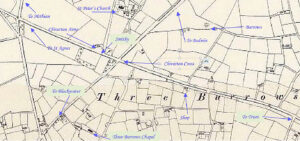 Three Burrows with the barrows which provided its name top right
Three Burrows with the barrows which provided its name top right

At first sight there is not a lot to say about the little community of Three Burrows. It has a church which has now closed, a chapel converted into a dwelling and a number of businesses which are mostly recent ventures. The Chiverton Arms public house is surely its oldest surviving commercial enterprise and it may be a surprise to some to know that its adjacent letting accommodation was once a smithy before becoming a part of an equestrian centre.
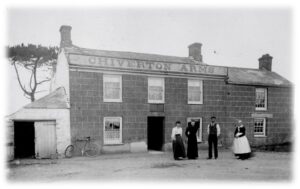 The famous Chiverton Arms which has provided for its customers since at least the 1830s.
The famous Chiverton Arms which has provided for its customers since at least the 1830s.
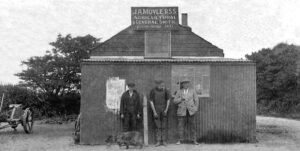 The blacksmith shop which became an equestrian centre before being converted into domestic accommodation.
The blacksmith shop which became an equestrian centre before being converted into domestic accommodation.
However, the subject of this article is an enterprise which was situated immediately adjacent to the Chiverton crossing, albeit on two locations. It began its life in 1898 and evolved into a business which became as well-known as the area it graced.
William Ward was born on the 12th July 1870 and commenced his business at the age of 28, as a wheelwright and undertaker. The location he chose was relatively isolated: at Three Burrows, next to where the St Agnes to Truro road crossed the main A30 road, a junction known as Chiverton Cross. How long, I wonder, has the crossing point existed. Surely, because of its strategic position, we can date this as long before the advent of motorised vehicles. Before even, the horse and cart was a common sight on our highways. It seemed strange that William did not select a more densely populated area. However, believing in his judgement, the business grew. In 1910 Kelly’s Business Directory listed it as a coachbuilder but William clearly believed in diversification and from the sign in the following photographs we can see that he increased his range of services to include wheelwright, carriage painter, undertaker and supplier of glass.
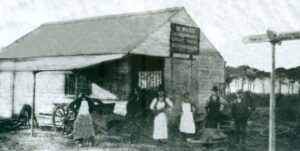 A too-good-to-leave-out early photo which, despite its quality, shows the workers in front of the building next to the finger-post sign at the Chiverton Crossing. It is not possible to determine what is written on the sign but to the left is Blackwater and Redruth, to the right is Bodmin and towards the trees, the road to St Agnes.
A too-good-to-leave-out early photo which, despite its quality, shows the workers in front of the building next to the finger-post sign at the Chiverton Crossing. It is not possible to determine what is written on the sign but to the left is Blackwater and Redruth, to the right is Bodmin and towards the trees, the road to St Agnes.
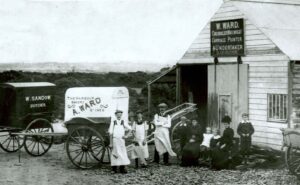 Probably a little later, and certainly much clearer, William Ward is third left and the two families on the right are probably his and that of Albert Ward of St Ives.
Probably a little later, and certainly much clearer, William Ward is third left and the two families on the right are probably his and that of Albert Ward of St Ives.
 Circa 1905: By now, the sign has been replaced, to some extent the lean-to has been incorporated into the building, another building has been erected, the crossing fingerpost has been removed and the business is still offering a range of services. It is mostly based on road transport although the sign still states undertaker. A smaller sign offers Carbide for sale.
Circa 1905: By now, the sign has been replaced, to some extent the lean-to has been incorporated into the building, another building has been erected, the crossing fingerpost has been removed and the business is still offering a range of services. It is mostly based on road transport although the sign still states undertaker. A smaller sign offers Carbide for sale.
William Ward had four sons who joined him in the business: Alphonso (Phonsy), Horace, Reggie and Cecil, and it is said that the business grew to the extent that it employed six other workers.
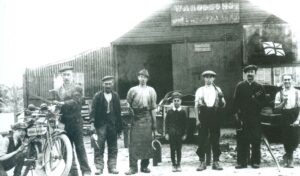 Here, the building has changed very little so perhaps it is of a similar date to the previous one. The two men with the motorbike and the chap with the oilcan are unknown but fourth left, with horseshoe in tongs, is Reggie and next to him is a young Cecil, and then Phonsy and William (father). The person on the extreme right is unknown.
Here, the building has changed very little so perhaps it is of a similar date to the previous one. The two men with the motorbike and the chap with the oilcan are unknown but fourth left, with horseshoe in tongs, is Reggie and next to him is a young Cecil, and then Phonsy and William (father). The person on the extreme right is unknown.
I am indebted to Clive Benney for this article from the West Briton and Cornwall Advertiser of the 13th February 1919:
W Ward
Wheelwright, Chiverton Arms, Cross Roads, Blackwater.
Begs to inform his numerous Customers and the public in general, that his SON, the Shoeing and Agricultural Smith, HAS RETURNED from the Colours with increased experience, and has RE-OPENED his Smith’s Shop, close to the Wheelwright Shop, where he is prepared to execute all classes of work in connection with the trade. Prompt attention. Prices moderate.
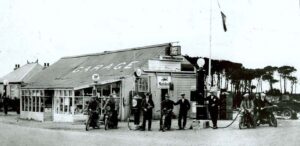 By the time this photograph was taken circa 1920 the business appears to be specialising in internal combustion vehicles. For some reason, the building at the rear of the garage has been removed, the lean-to has been fully incorporated and petrol pumps have been installed. To the left is William Ward’s bungalow.
By the time this photograph was taken circa 1920 the business appears to be specialising in internal combustion vehicles. For some reason, the building at the rear of the garage has been removed, the lean-to has been fully incorporated and petrol pumps have been installed. To the left is William Ward’s bungalow.
William’s bungalow was built in 1919 by Charlie Williams of Silverwell and it is still occupied by a member of the Ward family.
In 1923 William decided to add cycle agent to his offering and soon he was referring to it as a garage, motor engineers, general smiths and haulage contractors. Over the years, William was not slow to adapt to new opportunities to reflect the changes in transportation as it progressed through the era of bicycles, motorcycles and cars. Later, in 1939, he became a Chevrolet Agent.
Many accidents occurred at the crossing point and one, in 1925, was reported in the Cornubian and Redruth Times of Thursday the 16th July. A sad case when a young motorbike rider failed to take account of traffic on the main road and drove into the side of a car. Horace Ward had been standing in the garage doorway and spotted the vehicles approaching, he had tried to signal to them but they had collided and the motorcyclist was killed. Perhaps it was this accident which precipitated the plan to undertake alterations to the junction.
 William and Bessie (née Moyle) Ward in their 1919 bungalow which was to the left of the original garage
William and Bessie (née Moyle) Ward in their 1919 bungalow which was to the left of the original garage
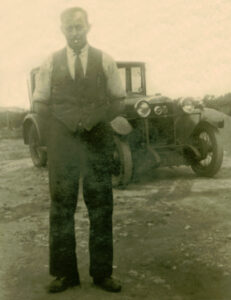 Alphonso Ward with a lovely Austin saloon in the background
Alphonso Ward with a lovely Austin saloon in the background
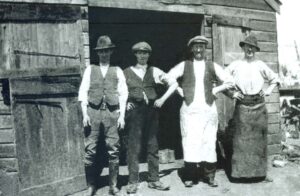 From left to right are Phonsy, Horace, William (father) and Reggie
From left to right are Phonsy, Horace, William (father) and Reggie
Sometime around 1930 the main road was widened and upgraded and because the re-aligned crossing encroached onto the garage site the business had to relocate. A new garage was built on the opposite corner. No doubt compensation was made for the loss of the original site and this provided the opportunity to build a substantial replacement.
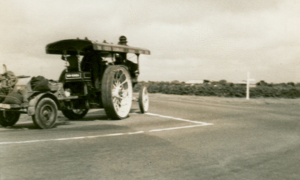 The improved junction with a steam engine turning off the St Agnes road to head towards Bodmin. The photograph was taken from the site of the first garage.
The improved junction with a steam engine turning off the St Agnes road to head towards Bodmin. The photograph was taken from the site of the first garage.
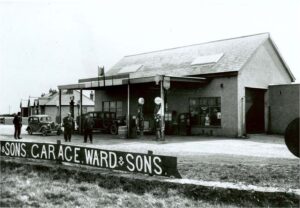 The new garage to the east of the old A30 road
The new garage to the east of the old A30 road
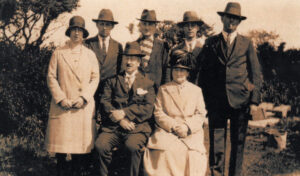 The Ward family
The Ward family
Standing: Myrtle, Alphonso, Horace, Cecil and Reggie
Seated: William and Bessie
William died on the 18th November 1946 and the sons took over the running of the garage. I knew Cecil best. His son, Michael, and I were friends and played together at my home in Silverwell, in the garage, and the lanes behind it. We were also frequent visitors to their daughter garage in Blackwater where we came across the old bass drum of Blackwater Brass Band which had disbanded many years before.
The history of the Blackwater location is also interesting and begins with Simon Tippett who was a bicycle repairer operating from his home on Blackwater West Hill before working from a building in the centre of the village – probably circa 1927.
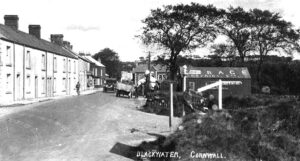 The original Blackwater Garage
The original Blackwater Garage
To accommodate the early 1930s road widening through the centre of the village the garage was demolished and rebuilt further back. The Cornwall County Agricultural War Executive Committee commandeered the corrugated galvanised building during the Second World War and extended it for use as an agriculture equipment workshop. This was the building which the Ward family bought and ran during the 1950s in conjunction with their garage at Chiverton Cross. Dennis Ward, the son of Alphonso and brother of George, managed it.
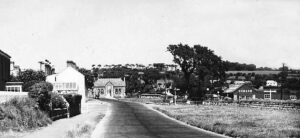 The garage following the 1930s road widening
The garage following the 1930s road widening
By now, it was a truly family business involving Alphonso’s sons, George and Dennis and Reggie’s son, Alan.
The founder’s sons were all involved in the Three Burrows garage and lived on or near its site. Phonsy and Cecil lived in two semi-detached bungalows just beyond the garage, on the Truro Road, Horace lived in the detached bungalow to the right of the garage and Reggie lived on the road towards St Agnes, on the left, just passed the Chiverton Arms.
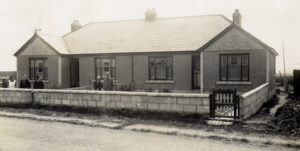 The semi-detached bungalows (Ward’s Row) of Alphonso and Lillian Ward to the left and Cecil and Mildred Ward to the right. These bungalows were eventually demolished to make way for a new development which included two filling stations.
The semi-detached bungalows (Ward’s Row) of Alphonso and Lillian Ward to the left and Cecil and Mildred Ward to the right. These bungalows were eventually demolished to make way for a new development which included two filling stations.
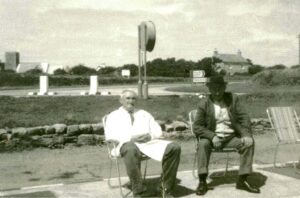 1960s: Petrol pump attendant, Jack Sandoe, on the left, with Alphonso Ward sunning themselves on the new garage forecourt. In the background is the crossroads and, beyond that, Mithian Church where I attended Sunday school before transferring my allegiance to the Methodists!
1960s: Petrol pump attendant, Jack Sandoe, on the left, with Alphonso Ward sunning themselves on the new garage forecourt. In the background is the crossroads and, beyond that, Mithian Church where I attended Sunday school before transferring my allegiance to the Methodists!
Even after the road alterations of the 1930s, the junction remained dangerous, particularly with the ever-increasing speed of cars. Those of you who remember the old Chiverton Crossing will recall the poor visibility to the north-east and the many accidents that occurred when drivers from Truro or St Agnes took their life in their hands and accelerated across the road. The conductor on the St Agnes bus had the task of checking for traffic coming from the Bodmin direction and one of his comments is remembered as, “All clear up the hill”.
By 1949 William and Bessie Ward’s bungalow was occupied by their grandson, George, and his wife, Ivy. It was beside the old A30 and on one occasion in the late 1960s, Ivy’s brother was visiting her and parked in her drive. Having found no one at home he decided to sit in the back garden until she returned but was disturbed by the sound of a crash. A westbound car had clipped a vehicle travelling across the junction and after skimming across the grass verge, had piled into his. There were many such accidents and Ivy reflected that it seemed like a weekly occurrence.
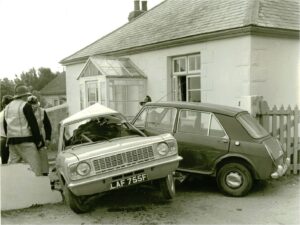 Ivy’s brother’s car on the left (Photo: courtesy Ivy Ward)
Ivy’s brother’s car on the left (Photo: courtesy Ivy Ward)
With so many accidents occurring it was decided to improve the visibility splays but any benefits of this alteration work was probably negated by the ever-increasing numbers and speeds of modern vehicles. It was eventually agreed that tinkering with the crossing was no longer an option and funds were found to implement major changes. In the late 1960s/early 1970s the crossing was replaced by a roundabout. This, of course, meant that motorists had to approach the junction at a somewhat slower speed.
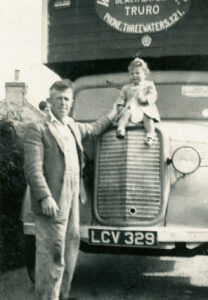 Ward’s Cattle lorry with one of its drivers
Ward’s Cattle lorry with one of its drivers
The name of W Ward and Sons Ltd became a by-word for garage but the family were quite entrepreneurial and included general haulage and cattle transportation in its offering employing many local men as drivers.
In July 1962 the business was still advertising its services but all things come to an end and by the following year it had been sold. It was the end of an era both for the family and for its huge customer base.
Malcolm Carter of Mount Hawke bought the business and ran it for the next ten years during which time it retained its feel as a local garage. It was from him that I bought my first new car: a 1967 light blue Triumph Herald.
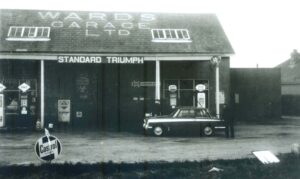 The garage after it became a Standard Triumph dealership. Despite the fact that it now had a new owner, the name of Wards Garage Ltd still burns bright on the roof.
The garage after it became a Standard Triumph dealership. Despite the fact that it now had a new owner, the name of Wards Garage Ltd still burns bright on the roof.
 William Ward’s bungalow, later rented and then purchased by George and Ivy Ward who moved to there in 1949.
William Ward’s bungalow, later rented and then purchased by George and Ivy Ward who moved to there in 1949.
Sometime in the 1970s the garage site was taken over by Chris Chapman who used the main building for car sales and developed the bungalow into a café and the buildings below it into a workshop.
 This photo was taken from George and Ivy Ward’s garden and shows that it had then become a Shell garage and that Horace’s old bungalow had become a café and later, Chiverton Auto Parts. Note the Mini on the forecourt.
This photo was taken from George and Ivy Ward’s garden and shows that it had then become a Shell garage and that Horace’s old bungalow had become a café and later, Chiverton Auto Parts. Note the Mini on the forecourt.
The name of Ward’s Garage Ltd, once proudly displayed on the roof, disappeared through the ravages of the Cornish weather, perhaps helped by a coat of paint. It was so imprinted on my mind that it required a visit to confirm that it was no longer there.
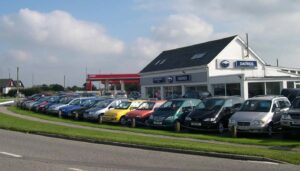 Almost up to date and in the ownership of Claude Holman Cars. Two filling stations stand side-by-side on the site of Ward’s Row with Starbuck’s café opposite.
Almost up to date and in the ownership of Claude Holman Cars. Two filling stations stand side-by-side on the site of Ward’s Row with Starbuck’s café opposite.
Since then, the site has changed considerably and is now home to a variety of businesses.
 Rowes Bakery and a repair garage at the rear
Rowes Bakery and a repair garage at the rear
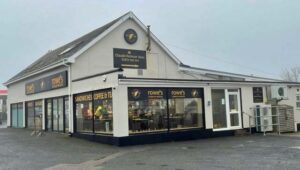 Rowes Bakery and Coffee Shop
Rowes Bakery and Coffee Shop
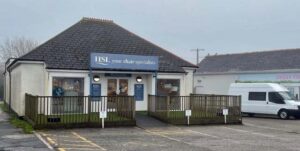 HSL Chair Specialists
HSL Chair Specialists
 Daisy Fays Nursery
Daisy Fays Nursery
Returning to the road layout: in 1988 the new Blackwater Bypass joined the roundabout from the south-west. It introduced a flow of faster moving traffic and as time progressed, and traffic volumes grew, the roundabout became increasingly unmanageable. This was recognised and in 2004, plans were drawn for an over-pass. It became apparent, however, that the funds were not going to be made available and Cornwall Council added additional lanes and created a new mini roundabout on the St Agnes junction, on the site of the old crossroads.
 The Roundabout with the new Blackwater bypass.
The Roundabout with the new Blackwater bypass.
 The 2004 arrangement with the route of the old roads and their crossing shown as dotted lines.
The 2004 arrangement with the route of the old roads and their crossing shown as dotted lines.
The roundabout that exists today is infinitely safer than the old crossroads but it is becoming busier each year and motorists take their life in their hands as they attempt to join the impatient flow of traffic. The vehicles thunder up and down the main A30 with many drivers hardly slowing as they charge across the busy junction to continue on their way. Vehicles from Truro, St Agnes and Newquay wait patiently for a gap in the traffic before attempting to join the flow but this can sometimes take an age. For some, perhaps the more reticent among us, the current roundabout is a place to be avoided if possible and the back lanes, despite their lack of passing places, are the preferred route. However, the accidents which do occur on the roundabout are mostly minor unlike if we wind back a few years to when it was a crossroads and when the crashes were truly horrific.
Now, in 2022, work is progressing with dualling the road between Chiverton Cross and Carland Cross with a new roundabout and an overpass. This will be located a short distance north-east of the old roundabout which will be removed and become just a memory and a part of Cornwall’s notorious highway history. Few will regret its passing and we hope that the new layout will prove to be safer and more popular than the present arrangement.
One final thought, considering the dangers and resultant accidents when the junction was a crossroads, William Ward’s decision to choose this location for a garage was perhaps not so strange.
My thanks to Ivy Ward, Clive Benney and Verna Moyle for photographs and information contributed for this article.
Postscript
In June 2024 the improved Chiverton Cross to Carland road opened, albeit with work on a number of link roads still to be completed. BBC Cornwall announced: “After four years, the new dual carriageway section of the A30 between Chiverton Cross and Carland Cross is open to drivers”.
In my introduction to this article I wrote: “it will not be long before some familiar landscapes will change for ever”. That is certainly the case and it is sometimes difficult to recognise them or even determine exactly where you are.
The inclement weather during the construction period certainly affected progress causing the contract to overrun by many months. However, the opening day arrived and a somewhat difficult road and the Chiverton Roundabout, was consigned to history. I have read some slightly affectionate comments recently ascribed to Chivvy Roundabout which I find surprising as its reputation before its demise seemed to be universally dreadful.
The new roundabout is located under the A30 spine road, to the east of the original, where the ground levels best-suited a two-level crossing.

Tony Mansell is the author of a variety of books, stories and articles on a wide range of aspects of Cornish history. He was made a Bardh Kernow (Cornish Bard) for his writing and research, taking the name, Skrifer Istori. He is a sub-editor with Cornish Story and a researcher with the Cornish National Music Archive specialising in Cornish Brass Bands and their music.

Splann !
Well, I never knew that ! what an interesting story. I hope it reaches the many hundreds of St Agnes folk who pass by without a clue of what was there before.
I shall have to go walk about when we next lunch at the Chiverton Arms.
Meur ras. John Wilson.
Very interesting article.
I just about remember the old cross roads and the garage. The Chiverton Arms has always been a popular pub for folks around the area and still is today.
Whenever we travelled along the A30 going towards Redruth, Mum would point out the tower of St Peter’s Church which could easily be seen from the road, and say ‘your great grandmother is buried in that church yard – she had red hair’. Great Grandmother’s name was Catherine Truscott nee Johns and she died in 1879 when the family lived at Roseinvale, Mithian. I have always wondered why she was buried there rather than St Agnes – maybe it was just a bit closer.
Enjoyed!!
Fascinating on 2 accounts. 1 I live in the lane opposite the shops in Blackwater but had no idea, according to those maps, that we once had a Chapel in the lane. 2 I trained with Heather Hunt at Chiverton Stables but also remember her parents once own the pub and that was when the equestrian side appeared. Stables were to the right and behind the pub, mucked out many times. Also hacked across Chiverton junction to the lanes and down towards the Chacewater road so remember the original garage all before the by-pass of course. Those were the days.
What an interesting story, the evolution of fuel retailing at Chiverton Cross. have been associated with fuel retailing (Still am at 80) I was really taken with this story.
A fantastic piece of social history with so many fascinating facts. I can remember the old crossroads and recall stories of members of my family who used to approach the crossroads at speed (from St Agnes) and switch their headlights off rather than stop to see if there was anything travelling on the A30… if they didn’t see any lights they would just go straight across!!!